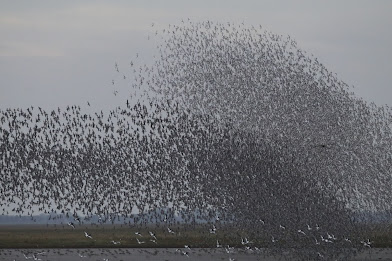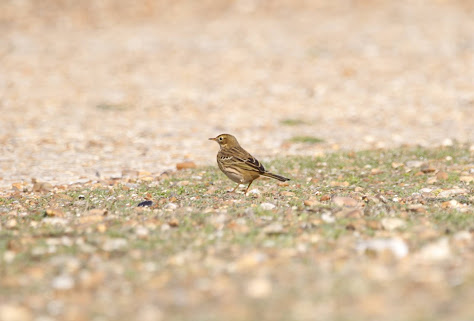Holkham is the largest National Nature Reserve (a reserve owned by the government body, Natural England) in lowland England. It comprises vast areas of saltmarsh, grazing marsh, conifer belts and beach. Its the last habitat that things get problematic, as the huge beaches attract the hordes of holiday makers which descend on the area like a plague. Even today, a mid October Monday there were hundreds of them. I know I shouldn't gripe, as every one needs access to the countryside, and in the end aren't I just one of the horde...
Anyway, away from the car park, the café and the beach, the horde are soon left out of sight. I concentrated on the grazing marsh, as its often the most productive of the habitats. A large conifer belt, planted on the dunes, separates this walk from the beach, so I didn't really meet any other people except birdwatchers, so it was fairly quiet. In the conifers were the usual woodland species and I heard just the one CROSSBILL fly over, but couldn't get a glimpse of any of the yellow browed warblers supposed to be hanging about. Sometimes you wonder if any of those birds were actually ever really recorded and or whether they were just made up.
The grazing marshes weren't flooded yet so didn't attract any ducks, yet large numbers of PINK FOOTED GEESE, had arrived. These geese (darker and smaller than greylags, with distinctive pink legs) have just started to return to the Norfolk coast, where they spend the winter here in big numbers. They'll graze the wet grassland and invade surrounding farmlands to feed. At Holkham the large skeins were coming and going, the distinctive noise they make really adds to the atmosphere of the place, the poetry of the desolate marshland. Also about was a GREAT WHITE EGRET, I don't know how long it will be before I stop mentioning a sighting of this bird, its becoming that common..
Holkham is well known for attracting rare birds, and today there was a twitch on. It involved a long slog to where the conifers ended, petering out into dunes to the west. A STEJNEGER' STONECHAT was present in an area of scrubby grassland. A species of stonechat from the Middle East, it handily did what all stonechats did and perched atop some brambles, posing for the admiring birders present. It was like a washed out stonechat with much more muted colours than our own native species. It was a smaller twitch to the ones I attended in my last blog, with around ten people present, as it was a less rare bird, less enticing.
This spot proved to be a good location. Birdwatchers accessing from the other direction informed me of the rare birds found over there. In the distance amongst the grazing cattle, there was a flock of CATTLE EGRET. Also in the distance, this time little more than a speck on the horizon, was a ROUGH LEGGED BUZZARD, which characteristically hovered like a kestrel. It was pointed out by some birders who had travelled from that direction, in the Scolt Head area. Also in the area were around six or seven RED KITE, a species that although still scarce in Suffolk, has really full on colonised Norfolk. Amongst the bushes in the dunes were a late LESSER WHITETHROAT, the latest I have ever seen one, and some BLACKCAPS.
Another decent showing from a high quality bird reserve. This area of North Norfolk may get overlooked, but I can see no reason why as it provides just as many birds as the other reserves. It is definitely well worth a look if you can deal with previously stated huge numbers of day trippers. As for this holiday I am on, in North Norfolk, I really am being spoilt. What a load of birds.



































